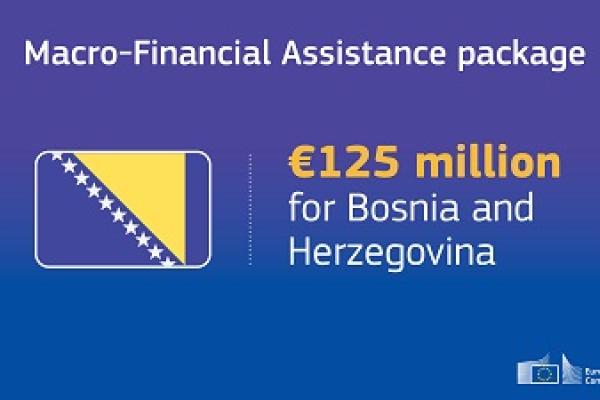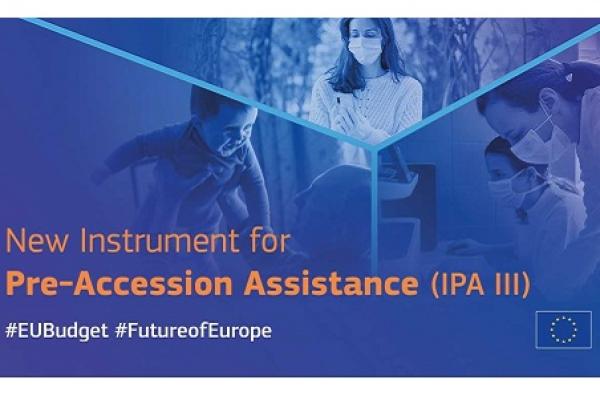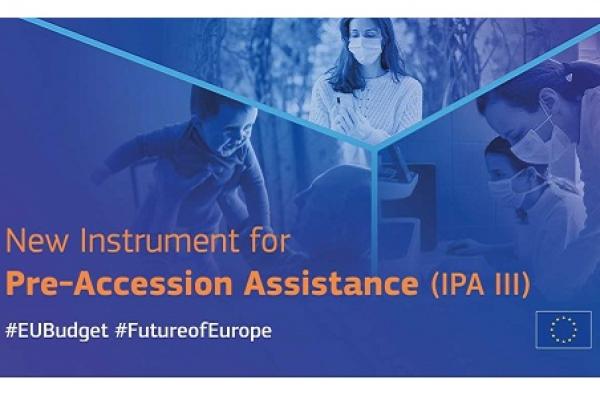The Instrument for Pre-accession Assistance (IPA) is the means by which the EU has been supporting reforms in the enlargement region with financial and technical assistance since 2007. IPA funds build up the capacities of the beneficiaries throughout the accession process, resulting in progressive, positive developments in the region.
For the period 2007-2013, the Instrument for Pre-accession Assistance (IPA) had a budget of €11.5 billion. Its successor, IPA II, was allocated €12.8 billion for the period 2014-2020. For the multiannual financial framework period 2021-2027, the IPA III budgetary envelope is €14.162 billion.
The current beneficiaries are: Albania, Bosnia and Herzegovina, Kosovo*, Montenegro, North Macedonia, Serbia, and Turkey. Assistance is also provided through multi-country / regional programmes.
*This designation is without prejudice to positions on status and is in line with UNSCR 1244/1999 and the ICJ Opinion on the Kosovo declaration of independence.
Purpose
The EU pre-accession funds are a sound investment into the future of both the enlargement region and the EU. They support beneficiaries to implement the necessary political and economic reforms, preparing them for the rights and obligations that come with the EU membership. Those reforms should provide their citizens with better opportunities and allow for the development of standards, equal to the ones we enjoy as citizens of the EU. The pre-accession funds also help the EU reach its own objectives including a sustainable economic situation, energy supply, transport, the environment and climate change, and stability.
IPA III (2021-2027)
The general objective of the IPA III instrument is to support the beneficiaries in adopting and implementing the political, institutional, legal, administrative, social and economic reforms required by those beneficiaries to comply with Union values and to progressively align to Union rules, standards, policies and practices with a view to Union membership, thereby contributing to their stability, security and prosperity.
The IPA III instrument is clearly aligned with the flagships and priorities of the ‘Economic and Investment Plan for the Western Balkans’ (October 2020), the Western Balkan Strategy ‘A credible enlargement perspective for and enhanced EU engagement with the Western Balkans (February 2018), and the Commission Communication ‘Enhancing the accession process – a credible EU perspective for the Western Balkans (February 2020).
IPA III presents a solid policy-driven approach, with strategic and dynamic deployment of assistance, putting the fundamental requirements for the EU membership at the core of the instrument. By further focusing EU financial assistance on key priorities, IPA III will leverage support to reforms fostering sustainable socio-economic development and bringing the partners closer to the Union’s values and standards. At the same time, it will be sufficiently flexible to adapt to the evolving situation in Turkey and reflect developments in EU relations with the country.
Legal basis of IPA III
The IPA III Regulation was adopted on 15 September 2021, came into force on 20 September 2021 and is applicable retroactively from 1 January 2021. The IPA III Regulation is complemented by the Commission Delegated Regulation, which was adopted on 1 October 2021 and came into force on 3 December 2021. It sets out specific objectives and thematic priorities for IPA III assistance. The IPA III Implementing Regulation was adopted by the Commission on 15 December 2021 and entered into force on 16 December 2021. Furthermore, the NDICI-GE Regulation, which was adopted on 9 June 2021, entered into force on 14 June 2021 and applies retroactively from 1 January 2021, sets out certain horizontal provisions, which are also applicable for IPA III assistance. The Commission adopted a model for a Financial Framework Partnership Agreement (FFPA) between the Commission and the governments of the IPA III beneficiaries on 31 March 2022. On this basis, individual FFPAs were agreed with the six Western Balkan beneficiaries and Türkiye and entered into force by the end of 2022.
IPA III Programming Framework
The IPA III Programming Framework, as described in Article 7 of the IPA III Regulation, is the overarching European Commission's strategic document for the use of EU funds assisting the IPA III beneficiaries for the duration of the 2021-2027 Multiannual Financial Framework. It replaces the previous country-specific strategy papers.
The programming framework 2021-2027 reflects the specific objectives of the IPA III Regulation and focuses on the priorities of the enlargement process according to five thematic windows, which mirror the clusters of negotiating chapters as per the revised enlargement methodology.
Programming of EU assistance is based on EU thematic priorities rather than pre-defined country envelopes. This will allow rewarding performance and progress towards key priorities and increased flexibility to respond to the evolving needs of the partners in their path towards accession.
For more information: How does it work?
IPA II (2014-2020)
Although the IPA II Regulation applied until 31 December 2020, implementation of IPA II funds is still ongoing.
Prepared in partnership with the beneficiaries, IPA II set a new framework for providing pre-accession assistance for the period 2014-2020.
The most important novelty of IPA II was its strategic focus. Indicative Strategy Papers were the specific strategic planning documents made for each beneficiary for the 7-year period. These provided for a stronger ownership by the beneficiaries through integrating their own reform and development agendas. A Multi-Country Strategy Paper addressed priorities for regional cooperation or territorial cooperation.
IPA II targeted reforms within the framework of pre-defined sectors. These sectors covered areas closely linked to the enlargement strategy, such as democracy and governance, rule of law, and growth and competitiveness. This sector approach promoted structural reforms that helped transform a given sector and bring it up to EU standards. It allowed to move towards a more targeted assistance, ensuring efficiency, sustainability and focus on results.
IPA II also allowed for a more systematic use of sector budget support and gave more weight to performance measurement: indicators agreed with the beneficiaries helped assess to what extent the expected results were achieved.
As of 31 December 2021, the Commission implemented 99% of the IPA II commitment appropriations and 59% of the payment appropriations.
Performance reward under IPA II
The performance reward was a mechanism set up in the Instrument for Pre-Accession Assistance II Regulation 231/2014 (Art 14). It provided a financial incentive for individual IPA II beneficiaries in case of particular progress made towards meeting the membership criteria and/or efficient implementation of pre-accession assistance. The Regulation twice foresaw the use of the performance reward scheme in the period 2014-2020 (current Multi-annual Financial Framework). The reward was first allocated in 2017, benefitting Albania, Kosovo, North Macedonia, Montenegro and Serbia with an overall amount of EUR 78 million.
The amount allocated for the 2020 performance reward exercise was also EUR 78 million. The Commission proposed to reward the two countries, which had undertaken the most significant steps to advance EU reforms: Albania and North Macedonia.
Legal basis of IPA II
The IPA II Regulation came into force on 16 March 2014 and was applicable retroactively from 1 January 2014. The IPA II Regulation was complemented by the Common Implementing Regulation (CIR), a set of simplified and harmonised implementing rules and procedures for all external action instruments, as well as the IPA II Implementing Regulation adopted by the Commission on 2 May 2014.
IPA (2007-2013)
The IPA Regulation for the period 2007-2013 expired on 31 December 2013, although some of its activities are still ongoing.
It was designed to provide financial assistance through five channels (known as "components"): transition assistance and institution building, cross-border cooperation, regional development, human resource development and rural development.
Key figures
IPA III 2021-2027 indicative allocations
The table below shows the indicative allocation for the period 2021-2027 to support the thematic priorities of IPA III programming framework. Prices are expressed in million Euro.
| IPA III Windows | % | 2021 | 2022 | 2023 | 2024 | 2025 | 2026 | 2027 | Total |
| Window 1: Rule of law, fundamental rights and democracy | 15,13 | 281 | 287 | 292 | 298 | 304 | 310 | 317 | 2.089 |
| Window 2: Good governance, EU acquis alignment, good neighbourly relations and strategic communication | 16,59 | 308 | 314 | 321 | 327 | 333 | 340 | 347 | 2.291 |
| Window 3: Green agenda and sustainable connectivity | 42,25 | 788 | 804 | 820 | 837 | 853 | 870 | 888 | 5.860 |
| Window 4: Competitiveness and inclusive growth | 22,31 | 414 | 422 | 431 | 440 | 448 | 457 | 467 | 3.080 |
| Window 5: Territorial and cross-border cooperation | 3,51 | 65 | 66 | 68 | 69 | 71 | 72 | 73 | 485 |
| Total Operational Budget | 100,0% | 1.855 | 1.894 | 1.932 | 1.971 | 2.010 | 2.051 | 2.093 | 13.804 |
| Administrative Appropriations | n/a | 49 | 49 | 50 | 51 | 52 | 53 | 54 | 357 |
| Total | 100,00% | 1.904 | 1.943 | 1.982 | 2.022 | 2.062 | 2.104 | 2.147 | 14.162 |
Current prices are calculated by applying annually a fixed deflator of 2% to the amounts in 2018 prices. Totals do not tally due to rounding.
IPA II 2014-2020 commitments*
|
Country |
2014 |
2015 |
2016 |
2017 |
2018 |
2019 | 2020 |
TOTAL |
|
Albania |
68.7 |
91.9 |
82.7 |
80.2 |
107.4 |
91.2 | 236.6 |
758.0 |
|
Bosnia & Herzegovina |
75.7 |
39.7 |
47 |
74.8 |
83.8 | 103.2 | 112.3 |
539.6 |
|
Kosovo* |
66.75 |
82.1 |
73.86 |
78.16 |
91.3 |
89.3 | 91.7 |
573.1 |
|
Montenegro |
39.5 |
36.4 |
35.4 |
41.4 |
44.2 |
42.3 | 31.7 |
269.2 |
|
North Macedonia |
81.7 |
67.2 |
64.6 |
82.2 |
99.2 |
111.0 | 127.2 |
633.0 |
|
Serbia |
189.1 |
216.1 |
189.4 |
166.7 |
214.1 |
211.0 | 218.1 |
1,404.4 |
|
Turkey |
619.6 |
625.7 |
629.2 |
508.6 |
386.8 |
248.3 | 168.2 |
3,186.5 |
|
Multi-country |
248.1 |
359.1 |
441.6 |
458.2 |
516.3 |
632.4 | 664.1 |
3,319.7 |
|
Total |
1,543.1 |
1,649.9 |
1,391.2 |
1,521.5 |
1,566.2 |
1,483.1 |
1,528.5 |
10,683.5 |
* Including DG AGRI (IPARD), DG REGIO (CBC with MS) and EAC (Erasmus+) and excluding contributions to FRIT (EU Facility for Refugees in Turkey) and TF Madad (EU Regional Trust Fund for Syria).
IPA I 2007-2013 commitments & payments
|
IPA per country |
Allocated |
Paid |
|
Albania |
520,936,906 |
468,761,852 |
|
Bosnia and Herzegovina |
521,771,765 |
517,805,176 |
|
Croatia |
813,387,940 |
730,474,435 |
|
Kosovo |
678,931,799 |
633,873,739 |
|
Montenegro |
206,088,976 |
191,172,886 |
|
North Macedonia |
478,459,905 |
427,126,925 |
|
Serbia |
1,344,571,356 |
1,207,596,526 |
|
Turkey |
4,392,763,734 |
3,960,513,063 |
|
Iceland |
23,213,454 |
6,151,472 |
|
Regional programmes |
1,361,053,085 |
1,323,712,918 |
|
Total |
10,341,178,920 |
9,467,188,992 |
|
Split per DG |
Allocated |
Paid |
|
NEAR |
6,358,307,027 |
5,843,823,624 |
|
REGIO |
2,502,820,607 |
2,297,294,455 |
|
EMPL |
552,185,053 |
467,670,252 |
|
AGRI |
927,866,233 |
858,400,660 |
|
Total |
10,341,178,920 |
9,467,188,992 |
Allocations = Level 1 Commitments (Decision Level) minus de-commitments.
Payments = Payments (advance payments; interim payments and final payments) made to the contractor (direct management) / beneficiary country or international organisation (indirect management).
News

The European Commission, on behalf of the EU, has disbursed €125 million in macro-financial assistance (MFA) to Bosnia and Herzegovina.

The European Commission welcomes the adoption on 15 September by the European Parliament of the new Instrument for Pre-accession Assistance (IPA III) for the period 2021-2027...

Dear Chair, Honourable Members of the Parliament, it is with great pleasure that I speak to you at this Plenary debate.
